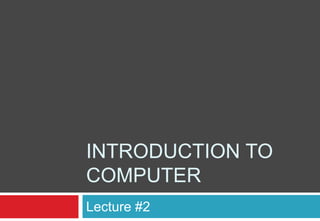
Generations of Computers
- 3. Generations of Computers 1st generation of computers (Based on Vacuum tubes) 1942-1959 2nd generation of computers (Based on Transistors) 1959-1965 3rd generation of computers (Based on Integrated circuits ICs) 1965-1973 4th generation of computers (Based on Microprocessors) since 1972 5th generation of computers (Based on Artificial Intelligence) In progress since 1980
- 4. 1st generation of computers (Based on Vacuum tubes)-1942-1959 In 1943, Electronic Numerical Integrator And Computer (ENIAC) was built at university of Pennsylvania. It contained nearly 18,000 tubes and consumed 150 Kilowatt of power. It was too big and weighed more than 30 tons. It could perform 5000 addition and hundreds of multiplications per second. They used vacuum tube for the circuitry and magnetic drums for memory.
- 5. Vacuum Tube
- 6. Electronic Numerical Integrator And Computer (ENIAC)
- 7. 1st generation of computers Cont.. In 1949 Electronic Delay Storage Automatic Calculator (EDSAC) was developed. EDSAC was the second electronic digital stored-program computer. It was the 1st computer which used stored program concept( The concept presented by Dr. John von Neumann). They worked on machine language.
- 8. Electronic Delay Storage Automatic Calculator (EDSAC)
- 9. 1st generation of computers Cont.. In 1944 EDVAC (Electronic Discrete Variable Automa tic Computer) was one of the electronic stored program computer. It had almost 6,000 vacuum tubes, and consumed 56 kW of power. It covered 490 ft² and weighed 7,850 kg.
- 10. EDVAC (Electronic Discrete Variable Automatic Computer)
- 11. 1st generation of computers Cont.. In 1951 the first commercially successful machine , ( UNIVersal Automatic Computer UNIVAC) was designed principally by J. Presper Eckert and John Mauchly. It could work 24 hours a day It used magnetic tape as input media.
- 12. , ( UNIVersal Automatic Computer UNIVAC)
- 14. Shortcomings of the 1st generation computers Very big in size. Slow in speed. Low reliability. Large power consuption. Difficult to maintain.
- 15. 2nd generation of computers (Based on Transistors)-1959-1965 They used transistor technology in them. they were small, reliable and consumed less power and produced less heat. The computers could perform a single operation in microseconds and could store huge data. They used magnetic tapes, magnetic dicks printers etc. They used assembly and High-level programming languages were also being developed at this time, such as early versions of COBOL and FORTRAN
- 16. Transistor
- 17. IBM 704
- 18. 3rd generation of computers (Based on Integrated circuits ICs)-1965- 1973 The development of the IC was the feature of the third generation of computers. An IC chip contained many components such as transistors, diodes and resistances interconnected with each other. . Transistors were miniaturized and placed on silicon chips, called semiconductors, which drastically increased the speed and efficiency of computers.
- 19. 3rd generation of computers… users interacted with third generation computers through keyboards andmonitors and interface d with an operating system. The computers were smaller in size, consumed less power and had high speed and storage capacity.
- 20. IC and Diodes
- 21. IBM System 360 model 85
- 22. 4th generation of computers (Based on Microprocessors)-1971-Present The microprocessor brought the fourth generation of computers, as thousands of integrated circuits were built onto a single silicon chip. The Intel 4004 chip, developed in 1971, it controlled all memory, input/output from the central processing unit chip. Fourth generation computers also used the d GUIs, the m.ouse and handheld devices
- 23. 4004 chip Intel 4004, the first commercial microprocessor.
- 24. microprocessor
- 25. microprocessor
- 26. 5th generation of computers (Artificial Intelligence) Present and Beyond These devices are based on artificial intelligence andare still in development. The goal of fifth-generation computing is to develop devices that respond to natural language input and they behave like human.
- 27. Examples
